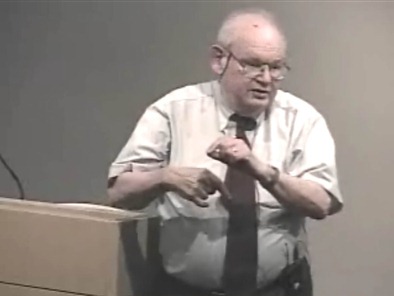It’s with great sadness that I read about the passing of Benoît B. Mandelbrot, renowned as the Father of Fractal Geometry. He taught me more about the universe than any other individual.
I first read about fractal geometry in the late ‘70s, probably in Scientific American or Byte magazine, and this inspired me to program my Exidy Sorcerer to generate Mandelbrot Set images.
The Exidy Sorcerer personal computer, 1978–1980.
Lest we forget, that machine had a Zilog Z80 processor running at 2 MHz, with 8 kilobytes of RAM (expandable to 32K); it took many minutes to generate a small monochrome view that was 100x100 pixels.
Old-skool monochrome Mandelbrot Set, circa 1979.
My fascination with fractals endured throughout the ‘80s – my final project in my Digital Systems class (6.111) was an EPROM / microcode implementation of a Mandelbrot Set engine. It could generate a 256x256 image in a minute or two.
Old-skool 256-color Mandelbrot Set, circa 1986.
As a senior in 1987, I was fortunate to attend a lecture by Professor Mandelbrot in the venerable room 10-250. He was charming, self-effacing, and spoke with a clarity that elicited little bursts of illumination in my brain.
The late ‘80s saw a wave of interest in fractal geometry, both in the scientific and popular literature. One of the best books to emerge was Michael Barnsley’s Fractals Everywhere, which brought a mathematical rigor to the subject that was accessible to dilettantes like me.
Fractals Everywhere, by Michael Barnsley, 1988.
This book inspired me to do a bit of analysis myself, so I persuaded my employer at the time (Boeing) to let me roam the company looking for chaotic dynamics in various data sets. It was a lot of fun, and I got a paper and a conference trip to New Orleans out of it.
My second encounter with Professor Mandelbrot was in 2004, when he gave a presentation to Microsoft Research, discussing his work in applying multifractal analysis to market data. With devastating efficiency, he eviscerated Black-Shoales and the underpinnings of portfolio theory (hint: market data are not IID). I suspect that he was not surprised by the global financial collapse of 2008.
The (Mis)behavior of Markets, by Benoit Mandelbrot and Richard L. Hudson, 2004.
Today, chaos theory and fractal geometry drift in and out of my career, with fun diversions like this generative architecture project:
Gennaro Senatore: Morphogenesis of Spatial Configurations, 2009.
Here’s a quick phase-space reconstruction of 100,000 millenia of simulated insolation on Summer Solstice at 65N latitude.
Poincaré map for 100 million years of Earth’s wiggles.
Benoît Mandelbrot’s work has formed the background for my entire adult life. Maybe he’ll receive a posthumous Nobel Prize. The man who gave us this certainly deserves it:
Partial view of the Mandelbrot set, by Wolfgang Beyer with the program Ultra Fractal 3.
Thank you, Benoît Mandelbrot.
















